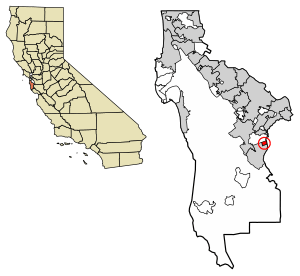Ladera, California facts for kids
Quick facts for kids
Ladera
|
|
|---|---|

Location of Ladera in San Mateo County, California.
|
|
| Country | United States |
| State | California |
| County | San Mateo |
| Government | |
| • Type | Community Association |
| Area | |
| • Total | 0.443 sq mi (1.146 km2) |
| • Land | 0.443 sq mi (1.146 km2) |
| • Water | 0 sq mi (0 km2) 0% |
| Elevation | 315 ft (96 m) |
| Population
(2020)
|
|
| • Total | 1,557 |
| • Density | 3,515/sq mi (1,358.6/km2) |
| Time zone | UTC-8 (Pacific (PST)) |
| • Summer (DST) | UTC-7 (PDT) |
| ZIP codes |
94028
|
| Area code(s) | 650 |
| FIPS code | 06-39094 |
| GNIS feature ID | 2628745 |
Ladera is a small community in San Mateo County, California. It is a residential area with about 520 homes. A group called the Ladera Community Association manages the community. Ladera is close to Portola Valley. In 2020, about 1,557 people lived there. The area uses the ZIP Code 94028 and area code 650.
Contents
Geography of Ladera
Ladera is found at the base of the eastern side of the Peninsula Range. This range is part of the Santa Cruz Mountains. To the west, Ladera is next to the Jasper Ridge Biological Preserve. This preserve is run by Stanford University. Alpine Road forms the eastern border, and Webb Ranch is to the north.
The community covers a small area. It is about 0.4 square miles (1.1 square kilometers) in size. All of this area is land.
History of Ladera
Early Days and Ranch Life
Long ago, the land where Ladera now stands was home to the Ramaytush Ohlone people. This was before Spanish settlers came to California. Later, the land became part of a large Mexican land grant called Rancho Corte de Madera.
For many years, the land was used for grazing animals and cutting timber. In 1927, it became part of the Ormondale Ranch. The Macdonough family owned this ranch. They raised cattle, sheep, and famous racehorses. One of their most well-known horses, Ormonde, had never lost a race in England. In the 1930s, most of the Ormondale Ranch became part of Portola Valley.
The Idea of a Cooperative Community
In 1944, a group called the Peninsula Housing Association (PHA) was formed. Their goal was to buy land and create a special type of community. This community would be a housing cooperative. In a cooperative, people work together to own and manage the property. Many important people from Stanford and Palo Alto joined the PHA.
By 1945, the PHA had 150 members. On July 31, 1946, they bought 260 acres (1.1 square kilometers) of the old Ormondale ranch. They paid $155,000 for the land. The PHA chose a famous landscape architect, Garrett Eckbo, to design the new community. Architects Joseph Allen Stein and John Funk designed some of the first model homes.
Naming Ladera and Early Challenges
The members chose the name Ladera for their new community. They picked this name to honor the Spanish history of the land. Ladera is a Spanish word that means hillside. The streets in Ladera also have Spanish names or names of plants. Some early members of the cooperative included author Wallace Stegner and Klystron tube inventor Sigurd Varian.
The PHA wanted to create a fair community. They refused to put rules on property deeds that would prevent certain groups of people from living there. However, the Federal Housing Administration (FHA) would not help with loans if the cooperative included African American members. This was an example of unfair housing practices at the time. Banks would not give loans without government approval. Because of these financial problems, the PHA cooperative failed. Only a few houses were built.
The PHA even suggested a system where the number of African American members would match their percentage in California's population. But this was still not enough for the government. The land was later sold to another company, Hare, Brewer, and Kelley. They finished developing the community. At first, homes were only sold to white families. Some non-white families who had bought land were forced to sell it. These types of rules became mostly illegal after a court case in 1948. They were fully outlawed by the Fair Housing Act of 1968.
A Step Towards Fairness
In November 2021, the community took an important step. Many property owners signed a petition. This petition asked to remove an old rule from the property deeds. This rule had said that only people "other than those of the Caucasian or white race" could not live there. The community voted to replace this rule with a new statement. The new statement says that the Ladera Community supports diversity, fairness, and inclusion. This shows a commitment to making Ladera a welcoming place for everyone.
Population Information
| Historical population | |||
|---|---|---|---|
| Census | Pop. | %± | |
| 2010 | 1,426 | — | |
| 2020 | 1,557 | 9.2% | |
| U.S. Decennial Census | |||
In 2010, Ladera had 1,426 people. By 2020, the population grew to 1,557. Most people in Ladera are white. There are also people of Asian, African American, Native American, and other backgrounds. A small number of people are of Hispanic or Latino heritage.
Most people in Ladera live in family homes. Many households have children. The community has a mix of age groups, including many adults aged 45 to 64 and a good number of seniors aged 65 and older.
A fun fact about Ladera is that in 2018, a business magazine called Business Insider said it was the most educated town in the United States.
See also
 In Spanish: Ladera (California) para niños
In Spanish: Ladera (California) para niños



